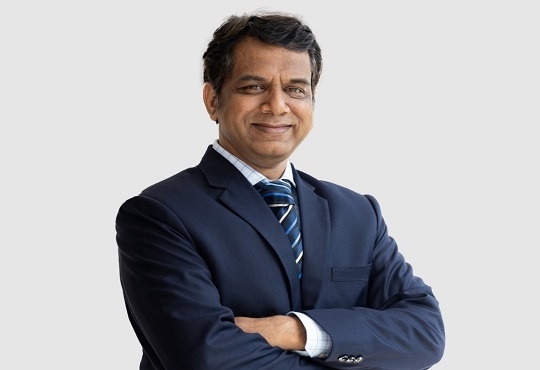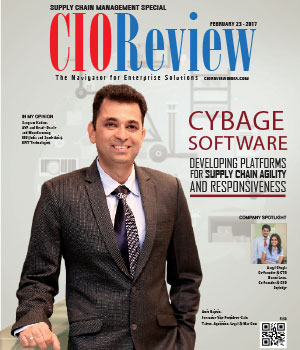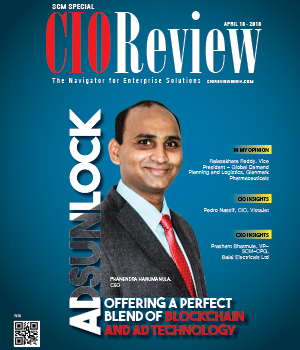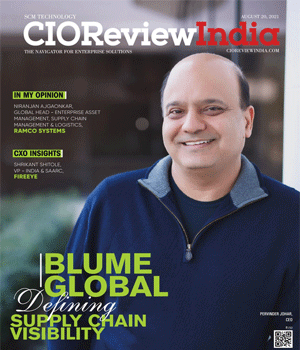
How Internet of Things is Transforming Supply Chain Management
Sangram Kadam, AVP and Head - Oracle and Manufacturing IBU (India and South Asia), KPIT Technologies | Thursday, 09 March 2017, 06:01 IST
 Alot has been said about the Internet of Things, or IoT, and its power to colossally change the way we interact with our devices as well as the physical environment we live in. While the adoption of IoT in the consumer space is well established, what is now becoming visible is its application in the industrial sector as concepts such as cloud computing, big data and analytics become mainstream.
Alot has been said about the Internet of Things, or IoT, and its power to colossally change the way we interact with our devices as well as the physical environment we live in. While the adoption of IoT in the consumer space is well established, what is now becoming visible is its application in the industrial sector as concepts such as cloud computing, big data and analytics become mainstream.
The Reach of IoT
What influence does the nexus of these technologies have on IoT, and what this mean for manufacturers? Fundamentally, IoT aids in the collection of data from different ‘Things’ - about operations, production, quality, utilisation, consumption, and more, and uses it to streamline and refine the business processes.
According to IDC, 2017 will see 60 percent of global manufacturers using analytics to sense and analyse data from connected products and manufacturing, and optimise increasingly complex portfolios of products. By 2018, the proliferation of advanced, purpose-built, analytic applications aligned with IoT will result in 15% productivity improvements for manufacturers with respect to innovation, delivery and supply chain performance.
IoT is slowly changing the way supply chain and logistics are being managed. With the explosion of data in supply chain processes, alarm systems and real-time monitoringhave become the entry-level applications for IoT. But as IoT evolves and organisations develop a specific IoT strategy, optimisation and prediction will get more focus.
Sensors, geo-location, cloud services, nanotechnology, 3D printing, big data, robotics, user interface (UI), augmented reality (AR), virtual reality (VR), and so on, when combined with IoT, can bring about radical change in supply chain management (SCM) processes. All areas, whether inbound or outbound, are being optimised, refined or redefined. The time to execute is beingreduced and outcome is enhanced, resulting in greater realisation and cost reduction.
Addressing the Challenges
Most manufacturers and logistics providers are on the lookout for data related to location, security, temperature and speed, to provide their customers with timely information.The biggest challenge, however, is in managing, analysing, leveraging and protecting all the data collected.
The ‘one-size-fits-all’ approach to IoT does not work. In emerging markets, such as India, for example, there are barriers in terms of adoption of the technology itself—and those should be addressed first.The best way to go about it would be to work towards addressing one problem at a time, having a good internal team, partners and finally, doing a proof of concept (PoC) before starting on a bigger scale. Despite the cost barriers to implementing IoT, a significant number of manufacturers are looking to expand their usage of IoT as the go-to technology for gaining real-time visibility.
One more factor for supply chain management companies to consider would be- a security policy which plays a key role nowadays. Today, only few organisations have adequate check and control mechanisms. Physical, digital and cloud security measures need to be taken so that both internal and external threats are addressed.
To get the full benefits of technologies such as IoT, companies should get the workforce ready by making them learn new concepts and unlearn the old ones. Showcasing small use cases in business areas will help them understand better. This, along with the vision and involvement of senior executives, will help achieve the desired results.
Closing Thoughts
Going digital is not just a one-time project, but a cultural-shift for organisations. It is the future and every company needs to have a digital plan in place, not only to grow but to survive as well. While many have started adopting the digital path, only a few have evolved. CIOs will continue to drive digitisation; however, the future will witness more Chief Digital Officers (CDO) managing it along with the Chief Executive Officers (CEO).Customer experiences, business processes and models are all very important from an organisation’s growth and strategy point of view, and they are getting redefined due to the digital journey.
Future investments will happen in areas such as fleet management, asset management, monitoring and diagnostics, warehouse management which includes stores and inventory management as well.
Over the next five years, there will be multi-folded growth in IoT. McKinsey estimates the total Internet of Things market size in 2015 was up to USD 900M, growing to USD 3.7B in 2020 attaining a 32.6percent CAGR. It has also estimated that IoT will have a potential economic impact of USD 2.7T to USD6.2T until 2025. The journey has just begun. Digital and IoT will drive growth and sustenance for the supply chain processes, with both inbound and outbound logistics, smart warehouse and fleet management to experience high level of adoption.
CIO Viewpoint
Role of IT in Enhancing Efficiency and...
By Sreenivas Pamidimukkala, Chief Information Officer, Mahindra Logistics
IT Overhaul in an Enterprise Transformation
By Parveen Aery, SVP & CIO, Ocwen Financial Solutions
Internet of Things: The Rise of Connected...
By Harnath Babu, Chief Information Officer, KPMG India
CXO Insights
Evolution of Supply Chain Management driven by...
By Shalabh Raizada, Chief Information Officer, Stellar Value Chain Solutions
Emerging Trends on Fruits & Vegetables Supply...










